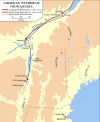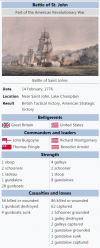"My God, these fellows have done more work in one night than I could make my army do in three months." General Howe, March 6, 1776
Siege
of Boston, April 19, 1775 - March 3, 1776
The end of the Siege of Boston which began as far back as June 14, 1775, finally came to an end during the early days of March, starting with the Fortification of the Dorchester Heights which overlooked the City of Boston, where William Howe had been stationed through much of the time since the Battle of Bunker Hill and when Thomas Gage was in overall command in the early stages of the Revolutionary War.
During the siege, in June 14 Congress voted to create the Continental Army out of the Militia units around Boston and appointed George Washington of Virginia as commanding General.
After Washington took command in July 1775, Colonel Henry Knox had proposed the idea of bringing the cannons from Ticonderoga to the siege. Knox himself was given the task, to transport the needed weapons from Ticonderoga to Cambridge.
Knox went in November, 1775, and over the three winter months, moved the 60 tons of cannons and other armaments by boat, horse and ox-drawn sledges through poor-quality roads, across two near frozen rivers, and through forests and swamps of sparsely inhabited Berkshires to the Boston area.
The success of the operation has been widely regarded as one of the most successful logistics feats of the entire war.
Within Boston, the British military leadership headed by general William Howe had been aware of the importance of the Dorchester Heights, alongside the heights of Charlestown, which possessed a commanding view of Boston and its outer Harbor. With how vital the harbor was to the British, much effort was made to its continued protection with the Royal Navy, first under Admiral Samuel Graves and later, under Admiral Molyneux Shuldham, provided protection and keep the Continental's at bay. As well as this, the Royal Navy provided protection of supplies being transported into the city.
Previously, efforts to lift the siege and capture of the Dorchester heights and other surrounding areas that overlooked Boston were made, culminating in the costly victory at the Battle of Bunker Hill where the British regulars and grenadiers were finally able to capture Bunker Hill and Breeds Hill from the Militia.
Neither the Americans or British dare attempt a move, even after Washington's arrival, when the Virginian considered capturing the unoccupied Dorchester Heights but gave up the idea fearing a British attack on the position would brush aside whatever force he could send to hold it. With what seemed to be a strong British presence in Boston, coupled with a lack of military supplies and gunpowder, the Committee of Safety (a shadow government) was unconvinced. Once Knox had arrived with the supplies, including Artillery, Washington was finally convinced to try.
Plan in Motion, March 2 - March 17, 1776
Following the arrival of artillery from Fort Ticonderoga, several batteries were set up overlooking the City of Boston and later, Boston Harbor itself. These including Lechmere's Point and Cobble Hill in Cambridge, and Lamb's Dam in Roxbury.
In order to utilize the crucial point of Dorchester Heights in the southern most part overlooking the harbor, several batteries were ordered to open fire on the town on the night of March 2 to which the British returned in kind without any significant loss of life for either side. The same followed suit during the night of March 3, whilst preparations continued.
March 4, 1776, was when things changed as during the night, whilst the batteries opened up once again, the British were distracted as the Americans made some final preparations to end the siege thanks to the planning of Rufus Putnam, a American military officer and veteran of the French and Indian Wars.
Due to the frozen ground of the Dorchester Heights, fortifying the position would prove difficult without the ability to dig in. Putnam, who had been a millwright, opted for a plan using chandeliers (heavy timbers, 10 feet long, use as frames) and
Fascines (large bundles of wood used to strengthen an earth structure and create a path across uneven, or wet terrain).
These were built out of sight of the British. Under General John Thomas, about 2,500 troops quietly marched to the top of Dorchester Heights, hauling tools, the prefabricated fortifications and cannon placements. Hay bales were used to muffle the sound of the troops activity, who spent the whole night setting up the cannon's and their placements to overlook Boston.
Washington, during this time, made his presence felt in order to encourage and keep up morale, reminding the soldiers of the approaching anniversary of the Boston Massacre on March 5. Work continued on with trees cut down and used to make
Abbatis to impede any foot assault from the British.
In response, Admiral Shuldham of the British fleet present determined the danger his ships were now under, and the need for the height to be taken. How and his staff would determine that to contest the occupation for the heights, would require 2,400 men and to attack under the cover of darkness. Washington was notified and reinforced the height until their were about 6,000 men present incase of an attack.
Ongoing snow storms beginning as late as March 5 prevented any military action for several days, leading Howe to eventually reconsider launching an attack and instead focus on preserving the army as much as possible for a battle elsewhere, rather then try and hold Boston. On march 8, intermediaries delivered an unsigned paper to Washington, warning that unless Howe's troops were allowed to leave, Boston would be burned to the ground.
Battle of Boston Harbor, March 16 - March 17, 1776
Following attempts by the British to destroy the fortifications in a two-hour cannon barrage, Howe alongside his officers agreed the colonists had to be removed from the heights if they were to hold Boston. This plan was given up in favor of a withdraw following a series of storms which occurred, preventing the British from launching the assault.
On March 8, a letter was sent to Washington that stated the British would not destroy the city if they were allowed to leave peacefully. Washington rejected the letter, in part due to it not being addressed to him either by name or title. Still, the letter did keep Washington at bay until March 9, when the British saw movement on Nook's Hill in Dorchester and opened a massive artillery barrage that lasted all night.
The barrage killed merely four men, but this response provoked the Americans and tension grew as the days went by. The next day, Colonists took the chance to go out and collect 700 cannonballs that had been fired at them.
On March 10, General Howe issued a proclamation ordering all inhabitants of Boston to give up all linen and woolen goods that could be used by the Colonists. During the next week, the British fleet waited in anchor for favorable winds while Loyalists and British Soldiers were loaded onto the ships. During this, American privateer ships captured several British supply ships bound for Boston.
On March 15, the wind became favorable for the British, but its sudden shift kept them from leaving. On March 16, another sighting of American forces spooked the British regulars into action, and in turn lead to British guns opening up a barrage upon the heights and soon a cannon duel began as American artillery opened fired upon the City and the still withdrawing British Loyalists and Soldiers.
Thanks to miscommunication, coupled with overly eager and on edge Captains and other officers, artillery continued to fire throughout the night and into the next day, by which time at around 4:00 a.m. a number of ships were loaded up and already sailing out. Most of these contained mostly civilians.
A total of 120 ships were present during the evacuation, however with the sudden and dramatic escalation in the fighting around Boston, several found themselves still moored and unable to move, whilst others fell victim to a series of cannonballs from American artillery up on the Dorchester Heights.
As Washington attempted to order a cease-fire, General Howe gave the word to set fire to the city, which began early at 1:00 p.m. and would consume much of the City by 11:00 pm.
Majority of the Loyalists had been evacuated, however a few 100 remained as panic gripped the populace whilst General Howe struggled to maintain order within the burning city. The fires soon reached the harbor itself and several ships were set ablaze or had already become the target of countless American artillery pieces and were now at risk of sinking in harbor.
General Howe alongside a final 230 troops were able to leave the city, however in their wake a remainder of 4,132 British regulars and Loyalist remained trapped. The remaining British soldiers present would surrender the following day and be taken prisoner, whilst remaining Loyalist citizens were allowed safe passage to Halifax, Nova Scotia.
In the aftermath of the Battle and withdraw of General Howe, the New England colonies were effectively safe from attacks through the remainder of the year and into the next. As the British fleet left, and Americans moved to reclaim what was left of Boston and surrounding areas, Captain Manley was ordered by Washington to harass the departing ships to which he saw some success and captured a ship carrying plunder.
"Had Sir William Howe fortified the hills round Boston, he could not have been disgracefully driven from it," wrote his replacement, Sir Henry Clinton. General Howe was criticized severely in the British press and parliament for the debacle and was stripped of his command in time for the up and coming New York and New Jersey campaign and Philadelphia campaign. Instead, Sir Henry Clinton would replace him as overall commander whilst General Burgoyne would be involved in the Ticonderoga campaign, a disaster that resulted in the capture of Burgoyne and 6,500 troops under his command.

